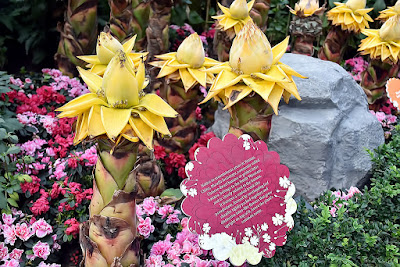Musella lasiocarpa is also called Chinese dwarf banana, golden lotus banana or Chinese yellow banana in reference to its port and its magnificent inflorescence golden yellow. This beautiful perennial shrub is very similar to the banana tree, its close relative. It is distinguished by its dwarf port and its very original flowering, which can last several months...
Musella lasiocarpa is also called Chinese dwarf banana, golden lotus banana or Chinese yellow banana in reference to its port and its magnificent inflorescence golden yellow. This beautiful perennial shrub is very similar to the banana tree, its close relative. It is distinguished by its dwarf port and its very original flowering, which can last several months. This relatively rustic plant produces many rejects, forming over time beautiful groups with opulent foliage, resistant to wind, cold and punctually dry soils. It is grown without difficulty in large bins, inside or outside. It likes fertile soils, fresh, but drained and likes the sun or half shade.
Musella lasiocarpa details:
The Musella lasiocarpa, is a plant of the family Musaceae, a native of China (Yunnan province) and Vietnam in altitude up to 2500 m. It is therefore rather hardy but not yet widespread enough in culture so that one can determine with accuracy its capacity of resistance. This species is very rare in its natural state and is only a survival due to cultivation.
It is a monocarpic perennial (which dies after fruiting) and tuberous rhizome. It is a small banana, forming many rejects at the base, reaching 1 m 50 to 1 m 80 in height. It is remarkable for its ornamental qualities, its hardiness and its speed of growth. A seed germinated in the spring can form a plant of 1 m 50 m in the space of a summer. The leaves are quite large, more fibrous and solid than banana trees, bluish green. Flowering can last from 6 months to a year. The apical bud then produces a dense spike of thick yellow bracts, evoking a lotus flower, carried by a thick stem. The small flowers develop at the base of the bracts. The fertilized flowers give way to small fruits containing seeds that germinate easily when they are fresh. It is a solid, persistent plant in a mild climate.
The Musella lasiocarpa is used in bulk or isolated, in vats or in the ground, in any area, it is hard enough to be acclimated in the ground, with or without protection depending on the climate. It goes well with cannas eg oranges, or variegated foliage. It is in itself an ornament for the terrace when it sits in a large tray. It will be able to store it in winter in a cold greenhouse, in a very bright location. In this use, it combines well with other orangery plants, such as oleander, citrus, Chilean myrtle, mimosa or Strelitzia reginae.
Grow and care Musella lasiocarpa:
Musella lasiocarpa should be grown in full sun or partial shade, in rich, rather cool, but well-drained soil, in the ground or in a large container. It tolerates fairly well short periods of drought and cold or snowy winters. Chinese dwarf banana fears water-soaked soils in winter. In very cold regions, or very humid in winter, it is useful to provide a layer of thick and loose straw, covered with a tarpaulin or transparent sheet to isolate the stump and young shoots of the humidity. These protections will be removed once the frosts have passed. The exposure must be sunny. The aerial parts are destroyed by frost from -2 ° C. They fall back on the stump, protecting the underground buds. New stems emerge vigorously and quickly in the spring, often accompanied by new releases. The plant is resistant to -12 ° C, and perhaps more. Clean the plant in the spring, once the frosts have passed.
The best time to plant this shrubs is March to May. If you grow this plant in pots, it is recommended substrate with ¼ garden soil, ¼ potting soil, ¼ coarse horticultural or pozzolan sand, and ¼ well decomposed manure, as it is a greedy plant. A bed of clay balls in the bottom of the mixture improves drainage. This plant, when grown in pots, wins to be out in the sun during the beautiful season. It often loses its leaves in winter, for lack of light. This plant can be wintered in a well-lit room, reducing watering. If some leaves change color in winter, it will not affect the health of the plant. Watering will be abundant during the summer, enriched every fortnight with a balanced liquid fertilizer.















COMMENTS